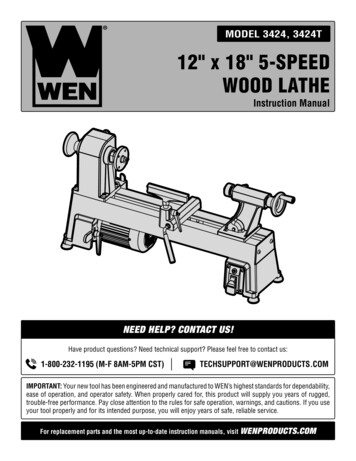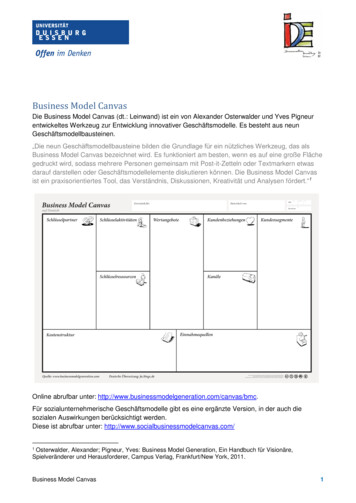
Transcription
MODEL 3424, 3424T12" x 18" 5-SPEEDWOOD LATHEInstruction ManualNEED HELP? CONTACT US!Have product questions? Need technical support? Please feel free to contact us:1-800-232-1195 (M-F 8AM-5PM CST)TECHSUPPORT@WENPRODUCTS.COMIMPORTANT: Your new tool has been engineered and manufactured to WEN’s highest standards for dependability,ease of operation, and operator safety. When properly cared for, this product will supply you years of rugged,trouble-free performance. Pay close attention to the rules for safe operation, warnings, and cautions. If you useyour tool properly and for its intended purpose, you will enjoy years of safe, reliable service.For replacement parts and the most up-to-date instruction manuals, visit WENPRODUCTS.COM
CONTENTSWELCOME3Introduction. 3Specifications. 3SAFETY4General Safety Rules. 4Wood Lathe Safety Warnings. 6Electrical Information. 7BEFORE OPERATING8Know Your Wood Lathe.8Assembly. 9Adjustments. 12OPERATION & MAINTENANCE14Operation. 14Maintenance. 19Exploded View & Parts List.20Troubleshooting Guide. 23Warranty Statement. 24To purchase chisels, lathe stands, live centers, and other accessories, visit WENPRODUCTS.COM2
INTRODUCTIONThanks for purchasing the WEN Wood Lathe. We know you are excited to put your tool to work, but first, pleasetake a moment to read through the manual. Safe operation of this tool requires that you read and understand thisoperator’s manual and all the labels affixed to the tool. This manual provides information regarding potential safetyconcerns, as well as helpful assembly and operating instructions for your tool.SAFETY ALERT SYMBOL: Indicates danger, warning, or caution. The safety symbols and the explanationswith them deserve your careful attention and understanding. Always follow the safety precautions to reduce therisk of fire, electric shock or personal injury. However, please note that these instructions and warnings are notsubstitutes for proper accident prevention measures.NOTE: The following safety information is not meant to cover all possible conditions and situations that may occur.WEN reserves the right to change this product and specifications at any time without prior notice.At WEN, we are continuously improving our products. If you find that your tool does not exactly match this manual,please visit wenproducts.com for the most up-to-date manual or contact our customer service at 1-800-232-1195.Keep this manual available to all users during the entire life of the tool and review it frequently to maximizesafety for both yourself and others.SPECIFICATIONSModel NumberMotorSwing Over BedDistance Between CentersSingle SpeedsSpindle TaperSpindle ThreadTailstock TaperQuill TravelTool Rest LengthFace Plate DiameterProduct DimensonsProduct Weight3424, 3424T120V, 60 Hz, 4.5A12 Inches18 Inches520, 900, 1400, 2150, and 3400 RPMMT21" - 8MT22 Inches7-7/8 Inches3-1/8 Inches30-1/4 in. x 8-3/4 in. x 16-1/4 in.70.3 lbs3
GENERAL SAFETY RULESWARNING! Read all safety warnings and all instructions. Failure to follow the warnings and instructions mayresult in electric shock, fire and/or serious injury.Safety is a combination of common sense, staying alert and knowing how your item works. The term “power tool”in the warnings refers to your mains-operated (corded) power tool or battery-operated (cordless) power tool.SAVE THESE SAFETY INSTRUCTIONS.WORK AREA SAFETY1. Keep work area clean and well lit. Cluttered or darkareas invite accidents.2. Do not operate power tools in explosive atmospheres, such as in the presence of flammable liquids,gases or dust. Power tools create sparks which may ignite the dust or fumes.3. Keep children and bystanders away while operatinga power tool. Distractions can cause you to lose control.ELECTRICAL SAFETY1. Power tool plugs must match the outlet. Never modify the plug in any way. Do not use any adapter plugswith earthed (grounded) power tools. Unmodified plugsand matching outlets will reduce risk of electric shock.2. Avoid body contact with earthed or grounded surfaces such as pipes, radiators, ranges and refrigerators.There is an increased risk of electric shock if your bodyis earthed or grounded.3. Do not expose power tools to rain or wet conditions.Water entering a power tool will increase the risk of electric shock.4. Do not abuse the cord. Never use the cord for carrying, pulling or unplugging the power tool. Keep cordaway from heat, oil, sharp edges or moving parts.Damaged or entangled cords increase the risk of electricshock.5. When operating a power tool outdoors, use an extension cord suitable for outdoor use. Use of a cordsuitable for outdoor use reduces the risk of electricshock.46. If operating a power tool in a damp location is unavoidable, use a ground fault circuit interrupter (GFCI)protected supply. Use of a GFCI reduces the risk of electric shock.PERSONAL SAFETY1. Stay alert, watch what you are doing and use common sense when operating a power tool. Do not use apower tool while you are tired or under the influenceof drugs, alcohol or medication. A moment of inattention while operating power tools may result in seriouspersonal injury.2. Use personal protective equipment. Always weareye protection. Protective equipment such as a respiratory mask, non-skid safety shoes and hearing protectionused for appropriate conditions will reduce the risk ofpersonal injury.3. Prevent unintentional starting. Ensure the switch isin the off-position before connecting to power sourceand/or battery pack, picking up or carrying the tool.Carrying power tools with your finger on the switch orenergizing power tools that have the switch on invitesaccidents.4. Remove any adjusting key or wrench before turningthe power tool on. A wrench or a key left attached to arotating part of the power tool may result in personalinjury.5. Do not overreach. Keep proper footing and balanceat all times. This enables better control of the powertool in unexpected situations.6. Dress properly. Do not wear loose clothing or jewelry. Keep your hair and clothing away from movingparts. Loose clothes, jewelry or long hair can be caughtin moving parts.
GENERAL SAFETY RULESWARNING! Read all safety warnings and all instructions. Failure to follow the warnings and instructions mayresult in electric shock, fire and/or serious injury.Safety is a combination of common sense, staying alert and knowing how your item works. The term “power tool”in the warnings refers to your mains-operated (corded) power tool or battery-operated (cordless) power tool.SAVE THESE SAFETY INSTRUCTIONS.7. If devices are provided for the connection of dustextraction and collection facilities, ensure these areconnected and properly used. Use of dust collectioncan reduce dust-related hazards.POWER TOOL USE AND CARE1. Do not force the power tool. Use the correct powertool for your application. The correct power tool willdo the job better and safer at the rate for which it wasdesigned.7. Use the power tool, accessories and tool bits, etc.in accordance with these instructions, taking into account the working conditions and the work to be performed. Use of the power tool for operations differentfrom those intended could result in a hazardous situation.8. Use clamps to secure your workpiece to a stablesurface. Holding a workpiece by hand or using yourbody to support it may lead to loss of control.9. KEEP GUARDS IN PLACE and in working order.2. Do not use the power tool if the switch does not turnit on and off. Any power tool that cannot be controlledwith the switch is dangerous and must be repaired.SERVICE3. Disconnect the plug from the power source and/orthe battery pack from the power tool before makingany adjustments, changing accessories, or storingpower tools. Such preventive safety measures reducethe risk of starting the power tool accidentally.CALIFORNIA PROPOSITION 65 WARNING4. Store idle power tools out of the reach of childrenand do not allow persons unfamiliar with the powertool or these instructions to operate the power tool.Power tools are dangerous in the hands of untrained users.5. Maintain power tools. Check for misalignment orbinding of moving parts, breakage of parts and anyother condition that may affect the power tool’s operation. If damaged, have the power tool repaired beforeuse. Many accidents are caused by poorly maintainedpower tools.6. Keep cutting tools sharp and clean. Properly maintained cutting tools with sharp cutting edges are lesslikely to bind and are easier to control.1. Have your power tool serviced by a qualified repairperson using only identical replacement parts. Thiswill ensure that the safety of the power tool is maintained.Some dust created by power sanding, sawing, grinding,drilling, and other construction activities may containchemicals, including lead, known to the State of California to cause cancer, birth defects, or other reproductiveharm. Wash hands after handling. Some examples ofthese chemicals are: Lead from lead-based paints. Crystalline silica from bricks, cement, and othermasonry products. Arsenic and chromium from chemically treatedlumber.Your risk from these exposures varies depending onhow often you do this type of work. To reduce your exposure to these chemicals, work in a well-ventilated areawith approved safety equipment such as dust masksspecially designed to filter out microscopic particles.5
WOOD LATHE SAFETY WARNINGSWARNING! Do not operate the power tool until you have read and understood the following instructions andthe warning labels.WOOD LATHE SAFETY1. This lathe is designed and intended for use by properly trained and experienced personnel only. If you arenot familiar with the proper and safe operation of a lathe,do not use it until proper training and knowledge havebeen acquired.2. Always wear eye protection and a face shield/dustmask when using the lathe.3. Do not wear loose clothing or jewelry when using thelathe. Keep your hair, clothing and gloves away frommoving parts. Loose clothes, jewelry or long hair can becaught in the spinning tool.4. Select the right tool for your task at hand. Make sureall tools, chisels and accessories are sharp before usingthem. Do not use dull or damaged tools.5. Select the appropriate speed for the task. Use slowerspeeds when starting on a workpiece. Allow the latheto ramp up to the operating speed before engaging anychisels, tools or other carving accessories.6. Check the workpiece carefully for splits, knots, nails,or other obstructions. These types of blemishes maycause a safety hazards during turning.7. If gluing up a workpiece for turning, always use a highquality glue that meets the needs of the particular workpiece to prevent the workpiece from falling off duringoperation.8. Cut the workpiece to a rough outline of the finishedshape before mounting it on the lathe.9. Rotate the workpiece by hand to check clearance withthe tool rest before turning the machine on.10. When turning between centers, make sure the headstock and tailstock are tight and snug against the workpiece.611. Never apply coolants or water to a spinning workpiece.12. Never stop a rotating workpiece with your hand.13. Do not change speeds until the machine comes to acomplete stop.14. Turn off and unplug the machine before doing anycleaning or maintenance. Use a brush or compressedair to remove chips or debris. Never use your hands toremove excess material and debris.These safety instructions can’t possibly warn of everyscenario that may arise with this tool, so always makesure to stay alert and use common sense during operation.
ELECTRICAL INFORMATIONGROUNDING INSTRUCTIONSIn the event of a malfunction or breakdown, grounding provides the path of least resistance for an electriccurrent and reduces the risk of electric shock. This tool is equipped with an electric cord that has anequipment grounding conductor and a grounding plug. The plug MUST be plugged into a matching outletthat is properly installed and grounded in accordance with ALL local codes and ordinances.1. Do not modify the plug provided. If it will not fit the outlet, have the proper outlet installed by a licensedelectrician.2. Improper connection of the equipment grounding conductor can result in electric shock. The conductorwith the green insulation (with or without yellow stripes) is the equipment grounding conductor. If repair orreplacement of the electric cord or plug is necessary, DO NOT connect the equipment grounding conductorto a live terminal.3. Check with a licensed electrician or service personnel if you do not completelyunderstand the grounding instructions or whether the tool is properly grounded.Fig. 14. Use only three-wire extension cords that have three-pronged plugs and outletsthat accept the tool’s plug. Repair or replace a damaged or worn cord immediately.CAUTION! In all cases, make certain the outlet in question is properly grounded. Ifyou are not sure, have a licensed electrician check the outlet.GUIDELINES AND RECOMMENDATIONS FOR EXTENSION CORDSWhen using an extension cord, be sure to use one heavy enough to carry the current yourproduct will draw. An undersized cord will cause a drop in line voltage resulting in loss of power and overheating.The table below shows the correct size to be used according to cord length and ampere rating. When in doubt, usea heavier cord. The smaller the gauge number, the heavier the cord.AMPERAGE4.5AREQUIRED GAUGE FOR EXTENSION CORDS25 ft.50 ft.100 ft.150 ft.18 gauge16 gauge16 gauge14 gauge1. Examine extension cord before use. Make sure your extension cord is properly wired and in good condition.Always replace a damaged extension cord or have it repaired by a qualified person before using it.2. Do not abuse extension cord. Do not pull on cord to disconnect from receptacle; always disconnect by pulling onplug. Disconnect the extension cord from the receptacle before disconnecting the product from the extension cord.Protect your extension cords from sharp objects, excessive heat and damp/wet areas.3. Use a separate electrical circuit for your tool. This circuit must not be less than a 12-gauge wire and should beprotected with a 15A time-delayed fuse. Before connecting the motor to the power line, make sure the switch is inthe OFF position and the electric current is rated the same as the current stamped on the motor nameplate. Runningat a lower voltage will damage the motor.7
KNOW YOUR WOOD LATHEUNPACKINGWith the help of a friend or trustworthy foe, carefully remove the wood lathe from the packaging. Donot discard the packaging until all of the parts below are accounted for. If any part is damaged or missing, please contact our customer service at 1-(800) 232-1195, M-F 8-5 CST or email us attechsupport@wenproducts.com.Back Cover KnobTool RestSpindleHeadstockHandleHandle ScrewBedMotor Support PlateMotor PulleyLocking HandleTailstock HandwheelTailstockMotorTool Rest Locking LeverTool Rest Locking HandleCircuit BreakerPower SwitchKnockout RodWrench3mm Hex Wrench5mm Hex WrenchFaceplateAccessory HolderLive Center (MT2) for TailstockSpur Center (MT2) for Headstock8
ASSEMBLYWARNING: To prevent injury from accidental operation, make sure the tool is switched OFFand unplugged from the power source before assembling or making any adjustments.REMOVING THE ANTI-RUST GREASEThe lathe bed and centers have been coated with grease to prevent them from rusting.1. Remove the excess oil and grease by wiping it off with a clean cloth.2. Remove any residue with a rag moistened with acetone, kerosene, or other removal agent. Wear gloves to protectyour skin. Do not use gasoline, or cellulose-based solvents such as paint thinner or lacquer thinner, as these willdamage the painted surfaces.3. Apply a light coat of good-quality paste wax to the surfaces to guard against rust and corrosion.INSTALLING THE HANDLE (FIG. A)1. Insert the handle screw (Fig. A - 1) through the handle (Fig. A - 2) andinto the hole of the handwheel (Fig. A - 3).322. Tighten the handle screw using a flathead screwdriver (not included).1INSTALLING THE TOOL REST (FIG. B)1. Loosen the locking handle (Fig. B - 1) and insert the tool rest (Fig.B - 2) into the tool rest base.Fig. A2. Adjust the tool rest height up or down to the desired position andthen tighten the locking handle (Fig. B - 1).2INSTALLING/REMOVING THE FACE PLATE (FIG. C)1. Mount the face plate (Fig. C - 1) onto the spindle by screwing it clockwise as far as it will go onto the spindle threads.2. Then insert the knockout rod (Fig. C - 2) into the hole to lock thespindle and use the wrench (Fig. C - 3) to fully tighten the face plate.1Fig. BTo remove the face plate, insert the knockout rod into the hole and usethe wrench to loosen the face plate.1231Fig. C9
ASSEMBLYINSTALLING THE SPUR CENTER (FIG. D)1. Make sure the mating surfaces of both the spur center andthe headstock spindle are clean.212. Drive the spur center (Fig. D - 1) into the workpiece (Fig.D - 2) using a rubber mallet or a piece of scrap wood.3. Push the spur center through the face plate into the spindleon the headstock.Fig. DNOTE: It is not necessary to remove the face plate toinstall the spur center.REMOVING THE SPUR CENTER (FIG. E)2The workpiece can be mounted between the spur center andlive center, or it can be mounted onto the face plate. Removethe spur center before mounting workpiece onto the face plate.11. Hold the spur center (Fig. E - 1) to prevent it from falling.Use a rag to protect your hand from the sharp edges.Fig. E2. Insert the knockout rod (Fig. E - 2) through the spindle holeto tap out the spur center.INSTALLING THE LIVE CENTER (FIG. F)1. Rotate the tailstock handwheel (Fig. F - 1) clockwise a fewtimes to advance the quill (Fig. F - 2) forward.2. Push the live center (Fig. F - 3) into the quill.132REMOVING THE LIVE CENTER (FIG. G)1. Hold the live center (Fig. G - 1) to prevent it from falling.Use a rag to protect your hand from the sharp edges.Fig. F2. Rotate the handwheel (Fig. G - 2) counterclockwise to retract the quill until the live center is released from the quill.12Fig. G10
ASSEMBLYINSTALLING THE ACCESSORY HOLDER (FIG. H & I)1. Position the accessory holder (Fig. H - 1) below the headstock on the back of the base. Align the holes and securethe accessory holder using two M5 12 pan head screws (Fig. H - 2). Tighten the screws using the 3mm hex wrench.You can organize your wrench, hex wrenches, knockout rod, live center and spur center into the accessory holderas shown in Fig. I.12Fig. HFig. IMOUNTING THE LATHE TO A BENCHTOP (FIG. J)For effective and safe operation, the lathe must be mounted to a bench table. Place the machine on a stable, flatwork surface. Make sure there is sufficient open space around the machine for operation and adjustments. Routethe power cord so that it will not make contact with the lathe’s moving parts.Refer to the graph below (Fig. J) for your lathe’s base dimensions. Mount the machine’s base to the benchtop withrubber feet in between to help dampen the vibration. Threaded holes on the lathe’s base are M8-1.25. Mountinghardware is not included.165mm 185mm737mm756mmM8-1.25Fig. J11
ADJUSTMENTSTOOL REST ADJUSTMENTS (FIG. K)1You can adjust the height, position and angle of the tool rest assembly(Fig. K - 1) to suit your task at hand. To adjust the tool rest:1. Loosen the small locking handle (Fig. K - 2) to raise and lower the toolrest or to adjust its angle. Tighten the handle to secure the tool rest.2. Loosen the locking lever (Fig. K - 3) on the tool rest base to slide thebase back and forth or to adjust its angle. Tighten the locking lever firmlybefore operating the lathe.23NOTE: Adjust the height of the tool rest just below the center of the workpiece, so that the tool will cut at the center of the workpiece.TAILSTOCK ADJUSTMENTS (FIG. L)Fig. K31. Loosen the tailstock locking lever (Fig. L - 1) and slide the tailstock intothe desired position. Retighten the locking lever.2. Loosen the quill locking handle (Fig. L - 2) to unlock the tailstock quill.Use the handwheel (Fig. L - 3) to advance and retract the quill. Retightenthe quill locking handle.21Fig. L12
ADJUSTMENTSSPEED ADJUSTMENTS (FIG. M TO P)This lathe has five speeds (520, 900, 1400, 2150 and 3400 RPM) asshown on the speed label (Fig. M). To change the speed:1. Loosen the back cover knob (Fig. N - 1), then pull up and open theback cover (Fig. N - 2) to access the spindle pulley.2. Loosen the side cover knob (Fig. O - 1), pull up and open the sidecover (Fig. O - 2) to access the motor pulley.3. Release the motor pulley locking handle (Fig. P - 1) and pull up onthe motor plate flange (Fig. P - 2) to loosen the tension on the drivebelt. Place the drive belt between the spindle pulley and motor pulleyas shown in Fig. M to achieve the desired speed setting.Fig. MNOTE: Always start at slower speeds for rough cuts and when working on larger workpieces. Use faster speeds for more refined cuts anddetailed work.4. Re-tension the belt tension and lock the handle. Replace the backcover and side cover.12Fig. N1221Fig. PFig. O13
OPERATIONTURNING TOOLSIf possible, select only quality high-speed steel turning tools. High-speed steel tools hold an edge andlast longer than ordinary carbon steel. As one becomes proficient in turning, a variety of specialty toolsfor specific applications can be acquired. The following tools provide the basics for most wood-turningprojects. Sharp tools must be used; do not use dull or damaged tools.1. Large roughing gouge - use this tool toshape square or out-of-round spindle-turning stock into a cylinder. This can also beused for creating shallow coves.45 bevelTurning rough stockround2. Skew chisel - the skew evens out high andlow spots to shape the cylinders. Vary angle atwhich the tip meets the workpiece to changethe aggressiveness of the cut. This can alsobe used for cutting beads and V-grooves. 70 skew3. Spindle gouge - the spindle gouge cutscoves, beads and free-form contours. It canalso be used for producing shallow hollowson faceplate turnings.Planing and Smoothing4. Parting tool - use the parting tool to formgrooves and tenons and to remove stock. Itcan also be used for rolling small beads.30-45 bevel30-40 bevelCove5. Bowl gouge - the bowl gouge cuts externaland internal profiles on faceplate-mountedstock, such as bowls and platters. It can alsobe used for creating ultra smooth cuts onbowls and spindles by using it as a shearingscraper.Shaping &Hollowing Bowls60-80 bevel14GrooveBeadTenon6. Round nose scraper - use this scraper fornon-agressive shaping of spindles and bowlsand to smooth out surfaces without removing too much stock.SmoothingBowls75-90 bevel
OPERATIONWARNING: To prevent serious injury, make sure all the warnings and instructions have beenread and understood before operating this tool.MOUNTING THE WORKPIECE BETWEEN SPINDLES (FIG. Q & R)Spindle turning takes place between the centers of the lathe. It requires a spur center in the headstock and a live center in the tailstock. Stock for spindles should be straight grained and free of cracks, knots, nails and other defects.A cup center rather than a cone center in the tailstock will often reduce the risk of splitting the stock.1. With a combination square, locate and mark the center on each end of theworkpiece. Accuracy is not critical on full rounds but is extremely important onstock where square sections are to remain. Put a dimple in the stock with anawl or nail (or use a spring-loaded automatic center punch).NOTE: Extremely hard woods may require kerfs cut into the ends of the stockusing a band saw, so the wood will accept the spur center and the live center.2. Drive the spur center about .1 inches (3 mm) into the workpiece (Fig. Q).Use a wood mallet or dead blow hammer. Be careful that you do not split theworkpiece. Never use a steel face hammer and never drive the workpiece ontothe spur center while it is mounted on the spindle of the lathe.Fig. Q3. Clean the tapered end of the spur center and the inside of the headstock spindle. Insert the tapered end of thespur center (with the attached workpiece) into the headstock spindle. Support the workpiece while loosening thetailstock locking lever and bringing the tailstock into position. Tighten the tailstock locking lever to lock the tailstockto the bed.4. Advance the tailstock quill with the hand wheel in order to seat the live center into the workpiece. Use enoughpressure to secure the workpiece between the centers so that it won’t fly off, but do not use excessive pressure.Excessive pressure runs the risk of overheating the center bearings and damaging both the workpiece and the lathe.Tighten the quill locking handle.5. Adjust the position of the tool rest to be parallel to the workpiece. The tool rest height should be just below thecenterline and approximately .1 to .2 inches (3 mm to 6 mm) from the corners of the workpiece to be turned. Securethe tool rest by tightening the tool rest locking handle and locking lever (Fig. R).6. Before switching on the lathe, rotate the workpiece by handto check for proper clearance.3-6mmCenterlineDirection of RotationFig. R15
OPERATIONROUGHING OUTBegin with a large roughing gouge (see page 14 for examples of common cutting tools).1. Place the tool on the tool rest with the heel of the tool on the surface to be cut. Slowly and gentlyraise the tool handle until the cutting edge comes into contact with the workpiece.2. Beginning about 2 inches from the tailstock end of the workpiece, roll the flute of the tool (thehollowed-out portion) in the direction of the cut.3. Make long sweeping cuts in a continuous motion to turn the piece to a cylinder. Keep as much of thebevel of the tool in contact with the workpiece as possible to ensure control and avoid catches.NOTE: Always cut downhill, or from the large diameter to the small diameter. Always work towards theend of the workpiece; never start at the cutting end.4. Once the workpiece is roughed down to a cylinder, smooth it with a large skew. Keep the skew handleperpendicular to the spindle and use only the center third of the cutting edge for a long smoothingcut (touching one of the points of the skew to the spinning workpiece may cause a catch and ruin theworkpiece).5. Add details to the workpiece with skews, parting tools, scrapers or spindle gouges.CREATING BEADSMake a parting cut for the desired depth and location of your bead.1. Place the parting tool on the tool rest and move the tool forward to make the full bevel of the toolcome into contact with the workpiece. Gently raise the handle to make cuts of the appropriate depth.Repeat for the other side of the bead.2. Using a small skew or spindle gouge, start in the center between the two cuts and cut down eachside to form the bead. Roll the tool in the direction of the cut.CREATING COVESUsing a spindle gouge to create a cove.1. With the flute of the tool at 90 degrees to the workpiece, touch the point of the tool to the workpieceand roll in towards the bottom of the cove. Stop at the bottom, as attempting to go up the opposite sidemay cause the tool to catch.2. Move the tool over the desired width of the cove. With the flute facing the opposite direction, repeatthe step for the other side of the cove. Stop at the bottom of the cut.16
OPERATIONCREATING V-GROOVESUsing the point of the skew to create a V-groove in the workpiece.1. Lightly mark the center of the V with the top of the skew. Move the point of the skew to the right halfof the desired width of your cut.2. With the bevel parallel to the right side of the cut, raise the handle and push the tool in to the desireddepth. Repeat from the left side.NOTE: The two cuts should meet at the bottom and leave a clean V-groove. Additional cuts may betaken to add to either the depth or the width of the cut.PARTING OFFAdjust the lathe to a slower speed for parting through a workpiece.1. Place a parting tool on the tool rest and raise the handle until is starts to cut. Continue cutting towards the center of the workpiece.2. Loosely hold on to the piece in one hand as it separates from the waste wood.SANDINGNOTE: The cleaner the cuts, the less sanding will be required. To sand your workpiece:1. Move away the tool rest and set the lathe to a low speed.2. Use sandpaper finer than 120 grit, as coarse sandpaper may scratch the workpiece. Fold the sandpaper into a pad will allow easier and safer sanding. Do not wrap the sandpaper around your fingersor the workpiece.3. Sand and progress through finer grits of sandpaper until the desired surface is achieved.FINISHING1. Turn off the lathe. The workpiece can be left on the lathe when applying finish.2. Apply the finish using a brush or paper towel. Remove any excess finish before restarting the lathe.3. Start the lathe at the lowest speed, as high speed may cause
WOOD LATHE SAFETY 1. This lathe is designed and intended for use by prop-erly trained and experienced personnel only. If you are not familiar with the proper and safe operation of a lathe, do not use it until proper training and knowledge have been acquired. 2. Always wear eye protection and a face s










